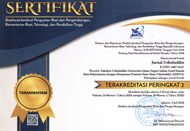Construction of Epistemological Interpretation on Eschatology Verses In ‘Aisyah ‘Abdurrahman al-Syati’s Perspective
Abstract
This study aims to examine the perspective of ‘Aisyaḧ ‘Abdurrahman al-Syati’ (1913-1998), as a contemporary female mufassir, regarding eschatological verses in surah al-Zalzalaḧ to prove the epistemological construction of interpretations based on sources, methods and validity of truth. The object of this research is the text and its relationship with past events, that a literature study is carried out to learn content analysis using a historical approach. The primary data in this study is the book of Tafsyr al-Bayany and supported by literature on the epistemology of interpretation in a philosophical approach. The results revealed that ‘Âisyah ‘Abdurrahman has interpreted surah al-Zalzalaḧ referred to Arabic language grammar, the prophet’s hadith, and previous interpretations. In the epistemology of interpretation, the verses about eschatology are not sufficient if they are interpreted in language separately, despite proving the validity of interpretive coherence, she remains consistent in using those method, even correspondingly the interpretation of zilzal is a picture of the earth’s condition when it shakes in accordance with the reality and scientific facts about earthquake, as well as in line with the argument about a doomsday that is bound to happen as found in terms in the Qur’an.
Keywords
Full Text:
PDFReferences
Abdurrahman, ’Aisyah. ’Ala Al-Jisr, Usturat Al-Zaman. Mesir: Dar Hilal, 1967.
———. Al-Tafsîr Al-Bayânî Li Al-Qur’ân Al-Karîm. Mesir: Dâr al-Ma’arif, 1977.
———. I’jaz Al-Bayani Li Al-Quran Al-Karim Wa Masail Ibn Azraq. Mesir: Dar al-Ma’arif, 1971.
———. Muqaddimah Fi Al-Manhaj. Cairo: Ma’had al-Buhu li al-Dirasah al-’Arabiyah, 1971.
Abu Hasan al-Qusyairi al-Naisaburi, Muslim bin Hajjaj. Shahih Muslim. Riyadh: Darul Mughni, 1998.
Al-Ali, Ali, Ahmad El-Sharif, and Mohamad Sayel Alzyoud. “The Functions And Linguistic Analysis Of Metaphor In The Holy Qur’an.” European Scientific Journal, ESJ (2016).
Al-Asyqar, Umar Sulaiman Abdullah. Al-‘Aqidah Fi Dau-Il Kitab Was Sunnah: Al-Qiyamah Al-Kubra. Kuwait: Dar Nafis, 1990.
Al-Bukhari, Muhammad Bin Ismail Abu Abdullah. Shahih Al-Bukhari. Beirut: Dar Ibn Katsir, 1987.
Boullata, Issa J. “MODERN QUR’N EXEGESIS A STUDY OF BINT AL‐SHĀTI’S METHOD.” The Muslim World (1974).
Che Zarrina Sa’ari, and Joni Tamkin Borhan. “Al-Qur’an : The Miracles of the Miracles.” Al-Bayan Journal of Al-Quran & al-Hadith (2003).
F. Stowasser, Barbara. Women in The Qur’an, Tradition, and Interpretation. Oxford: Oxford University Press, 1994.
Jansen, J.J.G. The Interpretation of The Qur’an in Modern. Leiden: E. Brill, 1974.
Kerwanto, Kerwanto. “ISLAMIC ETHICS BASED ON AL-QUR’AN AND MULLA ṢADRĀ’S ESCATOLOGY.” Teosofia (2017).
Khan, Sardaraz, and Roslan Ali. “CONCEPTUALISATION OF DEATH AND RESURRECTION IN THE HOLY QURAN: A COGNITIVE-SEMANTIC APPROACH.” Journal of Nusantara Studies (JONUS) (2016).
Kurdi, Alif Jabal, and Saipul Hamzah. “Menelaah Teori Anti-Sinonimitas Bintu Al-Syathi’ Sebagai Kritik Terhadap Digital Literate Muslims Generation.” Millati: Journal of Islamic Studies and Humanities (2018).
McLarney, Ellen Anne. Soft Force: Women in Egypt’s Islamic Awakening. Soft Force: Women in Egypt’s Islamic Awakening, 2015.
Musaddad, Endad. “METODE TAFSIR BINT AL-SYATHI.” ALQALAM (2003).
DOI: http://dx.doi.org/10.24014/jush.v28i2.10263
Refbacks
- There are currently no refbacks.
 Jurnal Ushuluddin Indexed By:
Jurnal Ushuluddin Indexed By:
Alamat Redaksi:
 Fakultas Ushuluddin UIN SUSKA Riau Jl. H.R. Soebrantas KM. 15,5 Panam – Pekanbaru
Fakultas Ushuluddin UIN SUSKA Riau Jl. H.R. Soebrantas KM. 15,5 Panam – Pekanbaru
 E-mail: jurnal.ushuluddin@uin-suska.ac.id
E-mail: jurnal.ushuluddin@uin-suska.ac.id
ejournal: http://ejournal.uin-suska.ac.id/index.php/ushuludin

Jurnal Ushuluddin is licensed under a Lisensi Creative Commons Atribusi 4.0 Internasional.



















